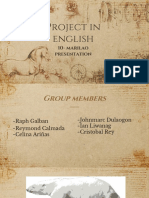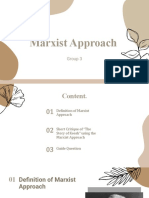Professional Documents
Culture Documents
Marxist Literary Critique - The Necklace
Marxist Literary Critique - The Necklace
Uploaded by
yehr velOriginal Description:
Original Title
Copyright
Available Formats
Share this document
Did you find this document useful?
Is this content inappropriate?
Report this DocumentCopyright:
Available Formats
Marxist Literary Critique - The Necklace
Marxist Literary Critique - The Necklace
Uploaded by
yehr velCopyright:
Available Formats
Rhey S.
Veloria
III BSE – ENGLISH
Marxist Literary Critique: The Necklace
Marxism is a major element in the novel, which is illustrated by the fact that Mathilde belongs to the
Politariet class in her society. This indicates that she will attempt to fit in or join the upper social classes.
In order to attend the ball, Mathilde is motivated by this feeling to borrow the necklace and purchase a
new fancy attire. But it creates a conflict in the narrative because she thought she couldn’t attend the
ball in her everyday, casual attire. She had the impression that she needed to belong to the upper strata
of society. She is only made aware of her status when she loses the necklace.
Additionally, there is a theme of class differences in The Necklace because Mathilde is conscious that
she is from a lower class. When she lost the necklace, she understood she would have to work hard to
save money to pay Madame Forestier back for the lost necklace. For ten years, until she runs into
Madame Foretier again to pay back the jewelry, she even downsized to a smaller home and her life
became more difficult. Because the necklace belongs to Madame Forestier, a member of the
Bourgeoisie, a higher class of person, she assumed it would be quite expensive.
In conclusion, The Necklace depicts the reality of the Politariet and Bourgeoisie classes of humanity.
Mathilde, a member of the Politariet class, has a difficult life compared to Madame Forestier, a member
of the Bourgeoisie, a high class society. Even if Mathilde wouldn’t lose the necklace, if she purchases a
false necklace due to her status, everything will remain the same for her. She lacks the resources to live
a life befitting someone of a higher social class. She must therefore be honest with Madame Mathilde if
she wants the situation to be fixed.
You might also like
- Applying Marxist Criticism On Anton Chekov's "The Bet"Document1 pageApplying Marxist Criticism On Anton Chekov's "The Bet"uncannyandunknown100% (1)
- Clash of The Titans Plot SummaryDocument3 pagesClash of The Titans Plot SummaryMarciano Ken Hermie50% (2)
- Marxist Critique (The Necklace)Document4 pagesMarxist Critique (The Necklace)Camille ashzleeNo ratings yet
- Local Media7550722409275348772Document4 pagesLocal Media7550722409275348772NOEL DE QUIROZNo ratings yet
- Pearl Irene Joy Nilo - q3 Assignment 8Document3 pagesPearl Irene Joy Nilo - q3 Assignment 8Pearl Irene Joy NiLoNo ratings yet
- Quarter Iv 20TH and 21ST Century Multimedia FormsDocument5 pagesQuarter Iv 20TH and 21ST Century Multimedia FormsAngela Marie AmatiagaNo ratings yet
- Noli Me Tangere, The OperaDocument13 pagesNoli Me Tangere, The OperaNicole Mendoza100% (1)
- English... Week 7Document3 pagesEnglish... Week 7Ak Sel GalloNo ratings yet
- Music 10 Module 7 Musical PlayDocument6 pagesMusic 10 Module 7 Musical Playearl ledesma0% (1)
- Expanded Definition: Micha Marie S. Cunanan 10 - Our Lady of FatimaDocument10 pagesExpanded Definition: Micha Marie S. Cunanan 10 - Our Lady of FatimaMicha Marie CunananNo ratings yet
- Reader ResponseDocument1 pageReader ResponsePatricia De Guzman BuenaventuraNo ratings yet
- Literary Approaches: Structuralist/ Formalist, Moralist, Marxist, FeministDocument16 pagesLiterary Approaches: Structuralist/ Formalist, Moralist, Marxist, FeministEntice AlmightyNo ratings yet
- Story of Keesh Group 5Document3 pagesStory of Keesh Group 5CJ Soriano100% (1)
- Persuasive Argumentative: ACTIVITY 1-Venn Diagram Identify One Similarity and Differences Among Writing TechniquesDocument1 pagePersuasive Argumentative: ACTIVITY 1-Venn Diagram Identify One Similarity and Differences Among Writing TechniquesRommer PublicoNo ratings yet
- Noter DamDocument6 pagesNoter DamAymen Al-badaniNo ratings yet
- Bullying An Informative EssayDocument2 pagesBullying An Informative EssayLovely Mae Diaz0% (1)
- Literary Critique Based On Specific Approaches Quarter 3Document10 pagesLiterary Critique Based On Specific Approaches Quarter 3Jonathan SmithsNo ratings yet
- KeeshpptDocument24 pagesKeeshpptLuke PettNo ratings yet
- The Appearance of The SorcererDocument2 pagesThe Appearance of The SorcererKriz BizNo ratings yet
- Historical Approach by Nina Romina G. NavaltaDocument23 pagesHistorical Approach by Nina Romina G. NavaltaNina Romina NavaltaNo ratings yet
- Q3-M3 CritiqueDocument6 pagesQ3-M3 CritiqueTeresita NuevaNo ratings yet
- Story of KeeshDocument5 pagesStory of KeeshMONEL CHUA100% (2)
- Hanchback of Notre DameDocument1 pageHanchback of Notre DameValguna Rivera ShaneNo ratings yet
- Analysis of The Dog Eater Using A Moralistic Approach To Evaluate The Different Ethical IssuesDocument2 pagesAnalysis of The Dog Eater Using A Moralistic Approach To Evaluate The Different Ethical IssuesEzri Mariveles Coda Jr.No ratings yet
- Your Journey: I.Pre-TestDocument14 pagesYour Journey: I.Pre-TestmikkaellaNo ratings yet
- Lesson3 StaticdynamicDocument2 pagesLesson3 StaticdynamicApriljay Celada SemenseNo ratings yet
- English 10 Quarter 3 Week 8Document59 pagesEnglish 10 Quarter 3 Week 8EJ BrazaNo ratings yet
- English 10 Quarter 4 - Week 4Document49 pagesEnglish 10 Quarter 4 - Week 4Geraldine MatiasNo ratings yet
- As1 Q3 English10 Verga FinalDocument8 pagesAs1 Q3 English10 Verga FinalMaureen AkimoriNo ratings yet
- Q3 - English 10Document40 pagesQ3 - English 10Ma'am JoneNo ratings yet
- The Story of Keesh: By:Jack LondonDocument8 pagesThe Story of Keesh: By:Jack LondonLorenz Christian LibaoNo ratings yet
- Marxist Approach PPT (NOPASS)Document12 pagesMarxist Approach PPT (NOPASS)France Nathaniel Canale100% (1)
- Proponents of Emw TheoryDocument20 pagesProponents of Emw TheoryJhayou AlonzoNo ratings yet
- ENG10-Q3-Module 4-Lesson 3-Critiquing-a-Literary-Selection-3 - DIGITALDocument18 pagesENG10-Q3-Module 4-Lesson 3-Critiquing-a-Literary-Selection-3 - DIGITALRubelyn Cagape100% (1)
- The Story of Keesh Critique PaperDocument2 pagesThe Story of Keesh Critique PaperErica Pau's Life0% (1)
- English 10 Weeks 4-5 Answer SheetDocument4 pagesEnglish 10 Weeks 4-5 Answer SheetKarla Lyca Sequijor EscalaNo ratings yet
- English10 Q3 Module 7Document25 pagesEnglish10 Q3 Module 7Jonnah SarmientoNo ratings yet
- English 10: What I Need To KnowDocument14 pagesEnglish 10: What I Need To KnowChelsea MedranoNo ratings yet
- English 10 Week 8Document2 pagesEnglish 10 Week 8Bong ReloxNo ratings yet
- How Odin Lost His EyeDocument1 pageHow Odin Lost His EyeAehr Agoir100% (1)
- Technology and Livelihood EducationDocument49 pagesTechnology and Livelihood EducationjustinekyleNo ratings yet
- The Analysis of The Story of KeeshDocument7 pagesThe Analysis of The Story of KeeshAlyanna JovidoNo ratings yet
- Lifting of Answers From The Internet Is Considered ZeroDocument14 pagesLifting of Answers From The Internet Is Considered ZeroBelinda Viernes100% (1)
- 4 Grade 10 Textual AIds - GALITDocument4 pages4 Grade 10 Textual AIds - GALITVinz Jegan GalitNo ratings yet
- Story of Keesh English 10 3rd QRTRDocument38 pagesStory of Keesh English 10 3rd QRTRIyen C. GarciaNo ratings yet
- Daedalus and Icarus SummaryDocument9 pagesDaedalus and Icarus SummaryExcel Joy MarticioNo ratings yet
- Week 3 4 Modules 8subjects PDFDocument139 pagesWeek 3 4 Modules 8subjects PDFmae KuanNo ratings yet
- English: Quarter 3 - Module 3Document8 pagesEnglish: Quarter 3 - Module 3Leizel Napone100% (1)
- English: Quarter 4 - Module 4: Observing Correct Grammar in Making DefinitionsDocument27 pagesEnglish: Quarter 4 - Module 4: Observing Correct Grammar in Making DefinitionsDanny Kintanar CarilloNo ratings yet
- Story of KeeshDocument19 pagesStory of Keeshbacon pancakesNo ratings yet
- (English Week1) : Activity 1: Parts of A DitionaryDocument9 pages(English Week1) : Activity 1: Parts of A DitionaryKenneth Del RosarioNo ratings yet
- Ida BDocument3 pagesIda BSharon BakerNo ratings yet
- Icarus and DaedalusDocument4 pagesIcarus and DaedalusSemajnat100% (1)
- Pre-Test in MAPEH 10: 3 QuarterDocument52 pagesPre-Test in MAPEH 10: 3 QuarterEliza CruzNo ratings yet
- KABANATA 1 Ni Ms. VillanuevaDocument32 pagesKABANATA 1 Ni Ms. VillanuevaInnaGarcia100% (1)
- Q4 LAS Arts 10-WK-5-8Document16 pagesQ4 LAS Arts 10-WK-5-8Liam AlexanderNo ratings yet
- 3rd Quarter Lessons in MapehDocument25 pages3rd Quarter Lessons in MapehCarodan Mark JosephNo ratings yet
- Critical Analysis About The Story "The Necklace"Document5 pagesCritical Analysis About The Story "The Necklace"Juzme Clhea MitcNo ratings yet
- Marxist Literary Criticism: by Guy de MaupassantDocument1 pageMarxist Literary Criticism: by Guy de MaupassantMaria Lee GarciaNo ratings yet
- The NecklaceDocument17 pagesThe Necklaceasdfjklalalalala75% (4)



























































